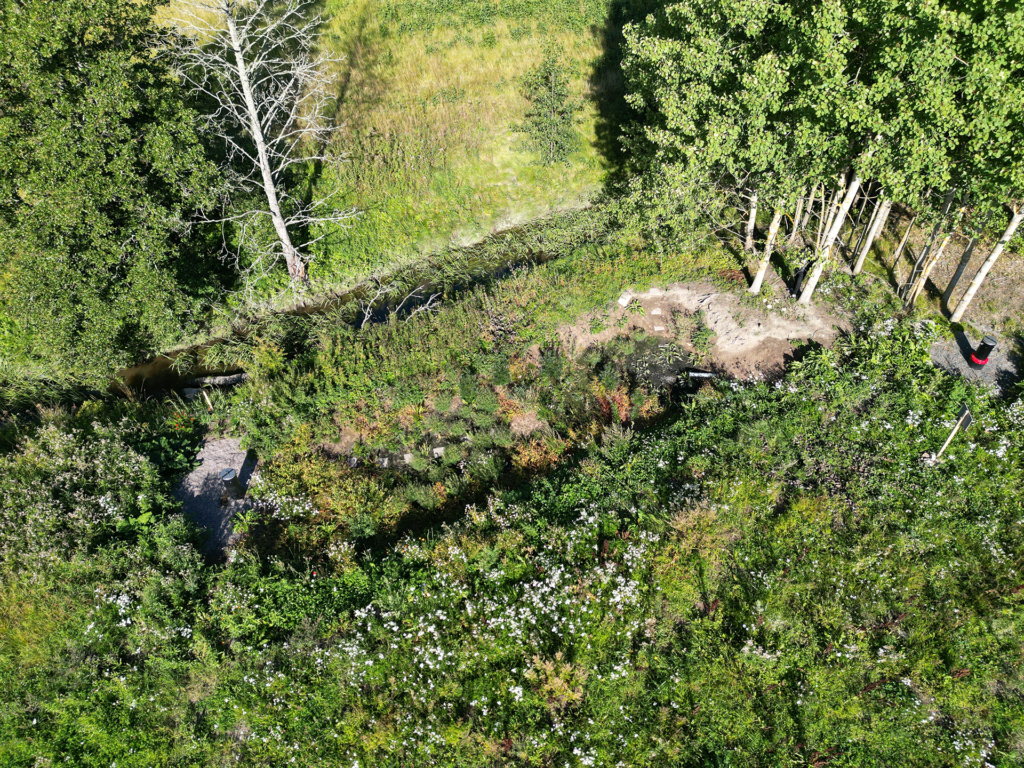Simulating function of decentralized stormwater management solutions

The Intelligent and Sustainable Stormwater Management (ISMO) project promotes sustainable stormwater management using decentralized solutions and integrated urban water management by developing digital solutions to support planning, operation and decision making.
Decentralized stormwater management solutions such as stormwater detention basins are becoming increasingly popular for managing stormwater in urban areas (see some of ISMO’s examples below).
Drone video footage of a rain garden structure constructed in the Kupittaa park in Turku.
In contrast to centralized solutions, for instance stormwater drainage pipes or combined storm- and wastewater sewers, these solutions capture rain and surface runoff from smaller areas and either infiltrate the water to the ground and evaporate it, or slowly release the water to conventional drainage systems or receiving water bodies. The benefit of such solutions is that they relieve peak flows in drainage systems during heavy rain events and thus may prevent local flooding, smoothen peak flows in receiving brooks and rivers which may reduce erosion of stream banks and beds and at the same time can retain pollutants. Decentralized solutions that are combined with vegetation, have positive local impacts on hydrology, heat islands and biodiversity.
The benefit of such solutions is that they relieve peak flows in drainage systems during heavy rain events and thus may prevent local flooding.
Though these solutions have been developed and used for decades, they are not yet mainstream in urban planning and design and water management. One of the limiting factors to their wider uptake is uncertainties in terms of water volume and pollution handling capacity, operation and management and lifespan. One tool to overcome these uncertainties is numerical models of hydrologic and hydraulic processes. These models use mathematical equations to simulate the physical processes involved in stormwater runoff and infiltration, such as the flow of water through the soil and the uptake of water by vegetation. By using these models, engineers, urban planners, and landscape architects can design decentralized stormwater management solutions that are optimized for their specific site conditions and can more accurately predict their performance in managing stormwater runoff.
Within the ISMO-project, Turku University of Applied Sciences researchers study and model the function of stormwater management structures. One of the objectives is to improve the design to maximize small-scale water and pollutant retention capacity and maximize the overall water quality benefits.
Examples of numerical simulations, analysing the progression of water during and after a rain event in a uniform retention system (see videos 1 and 2 below).
Simple theoretical model simulations can be used ot optimize the design of retention systems, with the aim to maximize retention capasity, by e.g, selecting soil layers of different grain sizes or varying the size and shape of the retention structure. Within the ISMO project we aim to develop models for water retention structure optimization in urban areas.
Text: Emil Nyman, Senior Advisor and Senior Advisor Jan-Hendrik Körber, Turku UAS
Simulations: Researcher Ashvin Chaudhari, Turku UAS


